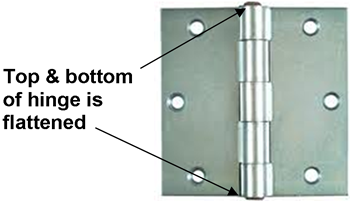Newer homes have exterior doors that open towards the interior of the home. However, in the past, exterior doors opened towards the exterior of the home, as shown in Figure 1. Exterior doors that opened outwards were thought to be more advantage as they did not take up interior space, the space needed to allow the door to open, and it has always been felt that a door that opens outwards is easier to escape from in the event of a fire.

Figure 1 - Exterior door with exposed hinges
That being said, when an exterior door opens outwards, the hinge pins are exposed. No matter what type of security locks, including dead bolts that you place on the door, if the hinges on the door are standard exterior hinges, the hinge pins can easily be removed making your home conveniently accessible to thieves.
If you have exterior doors that open outwards you can buy or make hinges that will provide substantially more security than standard exterior door hinges.
There are three different security hinges for outward swing exterior doors:

Figure 2 - Setscrew hinge
- Setscrew Hinges
- Stud Hinges
A setscrew locks the hinge pin to one side of the hinge, as shown in Figure 2. The setscrew is hidden when the door is in the closed position. Hence, the hinge pin cannot be removed when the door is in the closed position.
Setscrew hinges are often confused with non-removable pin hinges, however as you will see in Figure 4, a non-removable hinge pin is somewhat different.
For best results all the exterior door hinges on a specific door should have setscrews.
You can make your own setscrew hinge. Open the door and make a mark on the inside of the standard hinge parts that hold the hinge pins and cannot be seen from the outside when the door is in the closed position.
Take the hinges off the door and drill a hole in the spot you marked. Use a tap to thread the hole with a thread to match the setscrews that you have purchased. Replace the hinges and door, tighten the setscrew and the hinge pin can no longer be removed from the outside of the door.
Purchase security setscrew hinges.

Figure 3 - Stud hinge
- Non-removable Hinge Pins
Stud hinges allow the hinge pin to be removed, but when the door is in the closed position the studs prevent the door from separating from the door frame. As you can see in Figure 3, the studs fit into holes on the opposite sides of the hinge plates.
You can also make your own stud hinges by drilling a hole in the hinge plate that is on the frame, placing a piece of steel rod into the hole so that it protrudes approximately a 1/4 inch and then drilling an appropriate size hole in the hinge plate that is on the door. Reverse the procedure and place a piece of steel rod in the hinge plate on the door side and drill a hole in the hinge plate on the frame side so that it matches the position of the steel rod in the door. The steel rods do not have to be welded or bonded in any manner to the hinge.
Purchase security stud hinges

Figure 4 - Non-removable hinge pin hinge
A hinge with non-removable hinge pins is manufactured with a process that flattens both the top and bottom of the hinge pin, as shown in Figure 4, in a similar manner to a rivet, so that it cannot be removed.
Non-removable hinge pin hinges are also called crimped pin hinges and fast-riveted hinges.
The problem with these non-removable hinge pins is that the only way to remove the door is to remove the screws from the hinges on one side or the other.
You cannot conveniently make a hinge with non-removable hinge pins.
Purchase hinges with non-removable pins
Note: You can create hinges that have setscrews and a studs for double the security.
If you have an exterior door that swings outward you should consider one of the aforementioned security hinges.
